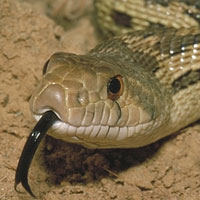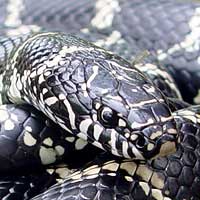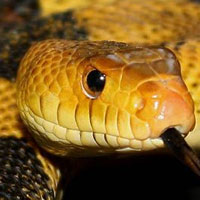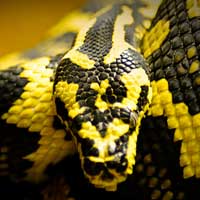Everything You Need to Know About the South American Rattlesnake
The South American Rattlesnake (Crotalus durissus) belongs to the Viperidae snake family, specifically the subfamily Crotalinae, which includes pit vipers characterized by heat-sensing pits and venomous fangs.
Scientific Name: Crotalus durissus
Snake Family: Viperidae
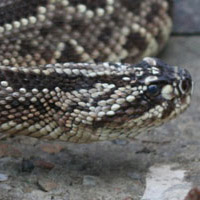
An Overview of the South American Rattlesnake
The South American Rattlesnake (Crotalus durissus) is one of the most widespread and iconic venomous snakes in the Americas. Found across Central and South America, this snake is instantly recognizable by its rattle, which it uses to warn potential threats. Known for its highly potent venom, the South American Rattlesnake plays a critical ecological role by controlling populations of small mammals and pests. Despite its reputation, it is not aggressive by nature and usually avoids human interaction unless provoked. Its adaptability to various environments makes it one of the most resilient rattlesnake species, thriving in habitats ranging from grasslands to arid deserts.
Where Does the South American Rattlesnake Live?
The South American Rattlesnake is a versatile species capable of thriving in diverse environments. Key habitat characteristics include:
- Geographic Range: Found throughout Central and South America, including countries like Brazil, Argentina, Paraguay, and Venezuela.
- Preferred Environments: Grasslands, savannas, forests, and semi-arid regions.
- Climate: Adaptable to tropical, subtropical, and arid climates.
This snake is often found near water sources such as rivers or wetlands, which provide hydration and attract prey animals. It also takes shelter in burrows, under rocks, or within dense vegetation to avoid predators and extreme weather. Below is a table summarizing its habitat preferences:
| Habitat Feature | Description |
|---|---|
| Geographic Range | Central and South America |
| Preferred Terrain | Grasslands, savannas, forests |
| Climate | Tropical, subtropical, arid |
What Does the South American Rattlesnake Eat?
The South American Rattlesnake is a carnivorous predator with a diet that reflects its role as an ecosystem regulator. Key dietary details include:
- Primary Prey: Small mammals such as rodents and rabbits.
- Occasional Prey: Birds, lizards, and amphibians, depending on availability.
- Hunting Strategy: Ambush predator that uses its camouflage to remain hidden and delivers a venomous strike to immobilize prey.
By preying on rodents, the South American Rattlesnake helps control pest populations, benefiting agricultural areas and reducing the spread of diseases. Its specialized diet and hunting efficiency make it a vital component of its habitat’s food chain.
Understanding the Behavior of the South American Rattlesnake
The South American Rattlesnake is known for its defensive and cautious behavior. Key traits include:
- Activity Patterns: Primarily crepuscular or nocturnal, becoming more active during cooler parts of the day or night.
- Defensive Behavior: Vibrates its rattle as a warning to potential threats and strikes only as a last resort.
- Social Behavior: Solitary, except during the mating season.
While not inherently aggressive, the South American Rattlesnake’s warning displays should always be respected to avoid accidental encounters or bites. Understanding its behavior is essential for coexisting with this iconic species.
Health and Lifespan of the South American Rattlesnake
The South American Rattlesnake is a robust species with a relatively long lifespan. Important health considerations include:
- Lifespan: 15-20 years in captivity, with slightly shorter lifespans in the wild due to predation and environmental factors.
- Health Threats: Habitat destruction, human persecution, and predation are significant risks.
- Predators: Birds of prey, larger mammals, and other snakes pose threats, particularly to juveniles.
Conservation efforts focused on habitat preservation and reducing human-wildlife conflict are vital for ensuring the survival of this species.
How Does the South American Rattlesnake Reproduce?
The South American Rattlesnake has a reproductive strategy that ensures the continuation of its species. Key details include:
- Mating Season: Occurs during the spring and early summer.
- Reproductive Method: Ovoviviparous, meaning females give birth to live young instead of laying eggs.
- Litter Size: Produces 10-25 offspring per litter, depending on the female’s size and health.
- Hatchling Behavior: Newborns are fully venomous and capable of hunting small prey immediately after birth.
The large litter size and independence of hatchlings ensure the South American Rattlesnake’s success in its natural habitats.
Safety Guidelines for Handling the South American Rattlesnake
Handling the South American Rattlesnake requires expertise and strict safety measures. Essential safety tips include:
- Use professional tools such as snake hooks and secure transport containers.
- Wear protective gloves and boots to minimize the risk of envenomation.
- Ensure enclosures replicate the snake’s natural habitat and are escape-proof.
- Keep antivenom readily available and have a detailed emergency response plan in place.
Only trained professionals should handle this species. Public awareness of its behavior and ecological role can help reduce fear and unnecessary harm to both humans and the snake.
Disclaimer
The information provided in this article is for educational purposes only. SnakeEstate strongly advises against handling or interacting with venomous snakes, such as the South American Rattlesnake, unless you are a trained and licensed professional. These snakes pose significant risks, and improper handling can result in serious injury or death. Always adhere to local regulations and prioritize safety when dealing with wildlife.
Other Snakes In This Species
 Asp Viper
Asp Viper Black Mamba
Black Mamba Boomslang
Boomslang Brazilian Coral Snake
Brazilian Coral Snake Bushmaster
Bushmaster Coastal Taipan
Coastal Taipan Common Death Adder
Common Death Adder Common European Adder
Common European Adder Copperhead
Copperhead Coral Snake
Coral Snake Cottonmouth
Cottonmouth Eastern Brown Snake
Eastern Brown Snake Eastern Diamondback Rattlesnake
Eastern Diamondback Rattlesnake Egyptian Cobra
Egyptian Cobra Fer-de-lance
Fer-de-lance Forest Cobra
Forest Cobra Indian Cobra
Indian Cobra Inland Taipan
Inland Taipan Jameson’s Mamba
Jameson’s Mamba King Cobra
King Cobra Lancehead
Lancehead Lataste’s Viper
Lataste’s Viper Malayan Krait
Malayan Krait Mojave Rattlesnake
Mojave Rattlesnake New Guinea Small-eyed Snake
New Guinea Small-eyed Snake Nose-horned Viper
Nose-horned Viper Puff Adder
Puff Adder Russell’s Viper
Russell’s Viper Saw-scaled Viper
Saw-scaled Viper Solomon Island Coral Snake
Solomon Island Coral Snake South American Rattlesnake
South American Rattlesnake Tiger Snake
Tiger Snake Western Diamondback Rattlesnake
Western Diamondback Rattlesnake



